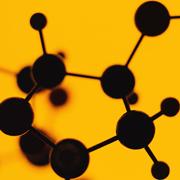 Molecules can be made between matter and antimatter - if only briefly.Getty
Molecules can be made between matter and antimatter - if only briefly.GettyTwo years after reporting the first tantalizing hints that matter might be able to bind with antimatter, researchers in California have nailed convincing evidence for the pairing.
David Cassidy and Allen Mills at the University of California at Riverside say that they have found the signature of a molecule in which two positrons — antimatter siblings of electrons — are bound together by electrons1. This hybrid substance is called molecular positronium, denoted Ps2.
Because electrons and positrons have equal and opposite charges, they can become bound together by their electrical attraction, just as a positively charged proton is orbited by an electron in ordinary hydrogen atoms.
In theory, positronium atoms — electron-positron pairs — should also be able to pair up to form molecules, just as two hydrogen atoms form H2. Because the mass of a positron is just 1/1836 that of a proton, positronium molecules are much lighter than hydrogen.
But Ps2 is peculiar stuff. Rather than being two well-defined atoms stuck together, the four particles "do a merry dance around each other in a fuzzy, lump-less soup", says physicist Clifford Surko of the University of California in San Diego.
Muzzy molecules
“Almost as soon as they are made, they disappear again with a puff and a flash of light”
Clifford Surko, University of California at San Diego
These molecules are very hard to see because matter and antimatter annihilate each other, releasing a burst of energy in the form of gamma-rays. When isolated in a vacuum, positronium atoms typically survive for less than a millionth of a second before they self-destruct. "Almost as soon as they are made, they disappear again with a puff and a flash of light," says Surko.
But Cassidy and Mills found that if they could capture enough positronium, some of the pseudo-atoms might combine before they vanish. If that happens, the positronium molecules would then release a characteristic gamma-ray signature when annihilation eventually occurs.
So the researchers fired a beam of positrons (made with a technique developed by Surko) into porous silica glass, in an attempt to pick up electrons and make Ps2. They estimated that they had a one-in-ten chance of two positronium atoms combining.
Mills and his colleagues first reported that this might happen in 2005 (see 'Did matter-antimatter mix yield molecules?' ). But it has taken until now to firm up the evidence.
Cool stuff
The clinching data come from looking at how the intensity of the gamma-rays changes as the temperature is altered. Electron-positron annihilation should be more rapid in Ps2 than in lone positronium atoms, because the binding increases the chance of collision. And the positronium mix should have a greater proportion of molecules at lower temperatures, since the cold makes molecules more stable. So the gamma-rays should become more intense when the mixture is cooled. That's exactly what the researchers saw, they report in Nature.
ADVERTISEMENT
Ultimately, says Surko, studying these blends of matter and antimatter could help to answer one of the most perplexing questions in fundamental physics: why is there so much more matter than antimatter in the Universe?
Mills also has a practical goal: to make Ps2 in sufficient quantities to create a laser from the very-high-energy gamma-rays released in annihilation. To achieve this, says Mills, "we have the ambitious goal of making not two but many thousands of positronium atoms interact with each other."
Visit our moleculesmad.html">newsblog to read and post comments about this story.
